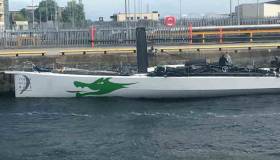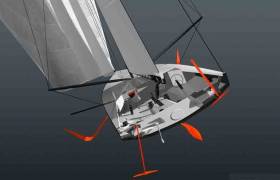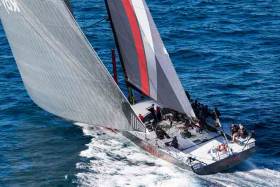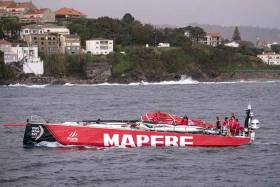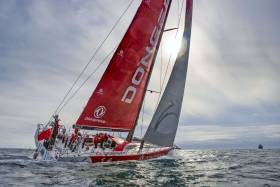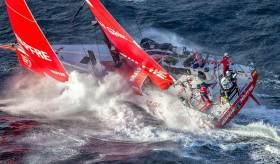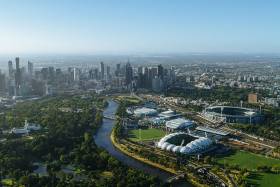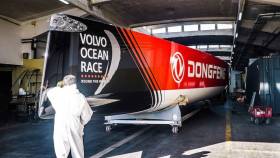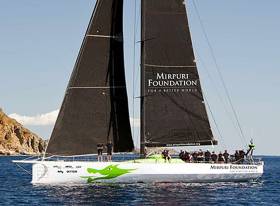Displaying items by tag: Volvo Ocean Race
Green Dragon Back in Galway Looking for a Mast
The Sino-Irish Volvo Racer Green Dragon has been having a somewhat checkered career since leaving Ireland, and though she took Transatlantic line honours in the ARC in December as the beginning of a Portuguese involvement in future Volvo Races, more recently she had the indignity of being dismasted.
Fortunately there’s a spare mast in her old home port of Galway, and she arrived in there yesterday to have it fitted. Afloat.ie will have more on this story as the week goes on.
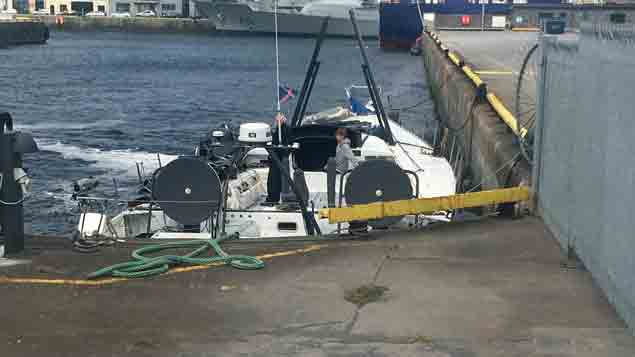 “I’m sure we left a spare mast here somewhere.....” Green Dragon returns to her old home port of Galway on a very specific mission. Photo: Pierce Purcell Jnr
“I’m sure we left a spare mast here somewhere.....” Green Dragon returns to her old home port of Galway on a very specific mission. Photo: Pierce Purcell Jnr
Billed as the 'most radical shake-up of the world’s leading round the world race since 1973', the Volvo Ocean Race today unveiled a series of radical initiatives that will create the toughest all-round test in professional sailing and strengthen the appeal of the 44-year-old round-the-world race to pro sailors, team owners and their sponsors, race partners, host cities and fans.
While the final preparations are being made for the 2017-18 edition, starting 22 October, race organisers used a live event at the Volvo Museum in Gothenburg, the home of the race’s owners and title sponsors, to present a bold vision for the next decade and beyond.
Highlights include the choice of a new 60-foot (18.29 metre) foil-assisted One Design ocean racing monohull, designed by France’s Guillaume Verdier, plus the introduction of a challenging 32-50 foot (10-15m) One Design ‘flying’ catamaran for In-Port Races, for which a new design and build tender process was launched today.
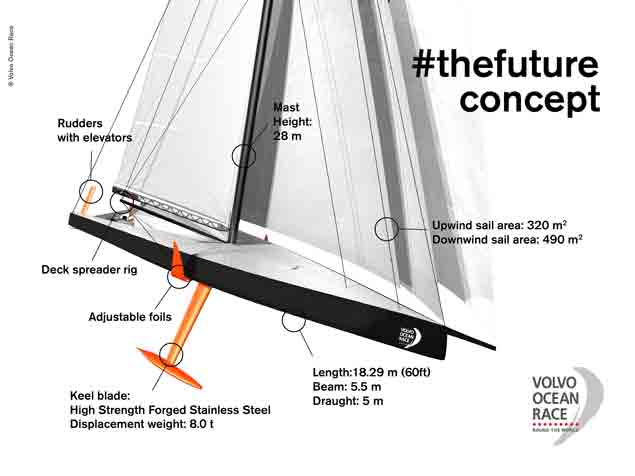 Volvo Ocean Race has unveiled a new monohull concept
Volvo Ocean Race has unveiled a new monohull concept
The offshore legs will remain the key to winning the Volvo Ocean Race, but the inshore racing will count more than the current situation, where it acts only as a tiebreaker. That means winning the race in future will demand expertise in both monohull racing offshore and multihull racing in the In-Port Series, as both platforms will be raced by essentially the same crew.
“Three hulls, but not what you might have imagined,” said Volvo Ocean Race CEO Mark Turner, revealing the choice of the next generation One Design boats, and referencing the difficult decision of whether to opt for a monohull or multihull design for the ocean legs, a subject that has been passionately debated by Volvo Ocean Race fans.
The race also announced new initiatives including:
Putting sustainability at the heart of the race with the Clean Seas campaign of United Nations Environment, and key partnerships with 11th Hour Racing and AkzoNobel that will significantly amplify the global campaign. The sustainability platform is central to the positioning of the race going forward.
Race activity every calendar year, and the launch of a three-edition Host City tender process with options for tradition-busting new routes and stopover formats.
Building the pathway to the Volvo Ocean Race for sailors and sponsors, via a partnership with World Sailing, the sport’s governing body.
A sponsor-focused Global Team Challenge that will form the centrepiece of a Leadership Development and Team Performance Programme – capitalising on race learnings for business and re-using the Volvo Ocean 65 boats after the 2017-18 edition for the on-water part.
“We had a lot of debate about multihull versus monohull and, in fact, the final solution for us is to do both, so there will be three hulls in future editions – a foil-assisted monohull and a ‘flying’ catamaran,” said Volvo Ocean Race CEO Mark Turner.
“The Volvo Ocean Race has always been the ultimate test of a team in professional sport and with these changes – collectively the most radical since the race began in 1973 – we are taking it up another level. The obsession that has led to generations of sailors putting everything on the line to win this race will continue, but to lift the trophy will require more skill, dedication and sacrifice than ever.
“We are staying true to our DNA as an ocean race but we will now also be testing the world’s best sailors to their limits inshore as well.
“At the same time, the commercial offering has so many extra elements added to it making it a powerful business transformation platform. We remain one of the few global, professional, world-class sporting events with a great commercial package that goes with it, with an outstanding Business to Business product, along with a rich heritage and strong consumer, media and employee activation options, much of it built into the campaigns.
“We are fortunate as well to have such strong and consistent backing from our owners Volvo, two decades on from their acquisition of the event. The race has never been in such a strong position as we look to the next decade and beyond.”
Volvo announced the agreement to buy the race from former owners Whitbread 20 years ago and has provided vision and staunch backing ever since.
“Volvo said at the time that the race successfully brings together adventure, sport and high level technology,” said Volvo Group’s Henry Sténson, Executive Vice President for Communication & Sustainability Affairs.
“So while much has changed in the last 20 years, fundamentally, nothing has changed. We’re particularly excited to see the Volvo Ocean Race reinforce that commitment to innovation – an area that is so important to us at Volvo Group.”
In addition, Björn Annwall, Senior Vice President for Strategy, Brand & Retail at Volvo Cars, highlighted the race’s renewed commitment to sustainability.
“Volvo Car Group has been involved in sustainability projects for a long time and we’re excited to see the race strengthen its position as a sporting event that is so in tune with its ocean environment and one that inspires such passion.”
Volvo Ocean Race: The Next Decade
Key announcements from the Gothenburg event:
Sailing’s ultimate test: From the edition after 2017-18, the Volvo Ocean Race will be contested in a combination of a 60-foot foil-assisted monohull for the ocean legs and a 32-50 foot ‘flying’ catamaran for use in the In-Port Race Series. Together, they will establish the Volvo Ocean Race as sailing’s ultimate all-round test and strengthen its reputation as the ultimate test of a team in professional sport.
Foil-assisted monohull: The One Design monohull from the in-demand French naval architect Guillaume Verdier will use the latest generation foiling technology to make it incredibly fast to sail and spectacular to watch. Crew numbers are likely to be between 5 and 7, with incentives continuing for mixed male-female crews and youth sailors. The race will build eight of the new monohulls and deliver them from January 2019 onwards. They will be available to lease by teams to reduce campaign start-up costs, with sponsors involved in the current 2017-18 race to be given first option when Notice of Race and Commercial Participation Agreements are published this October.
IMOCA compatibility: Uniquely, the design brief retains an option to allow the boat platform to be converted, inexpensively and quickly, to a fully rules-compliant short-handed IMOCA boat. The 60-foot IMOCA class boats, used in iconic races such as the solo Vendée Globe, have been the drivers of some incredible technical innovation over the past few decades.
‘Flying’ in-shore catamaran: Additionally, the race is launching a tender process for a new One Design 32-50 foot ‘flying’ catamaran for use inshore – a boat that will use some of the technology familiar from the America’s Cup and other new multihulls, albeit in a non-development One Design mode.
A sustainable future: The race has three pillars of action on sustainability – reduce its own footprint, maximise its impact using its global communications platform, and leave a positive legacy wherever it goes. Centred on a partnership with the United Nations Environment Clean Seas campaign, the focus will be on the call to action ‘Turn the Tide on Plastic’. A founding partnership with 11th Hour Racing is providing the resource to permit significant amplification across all Science, Education and Ocean Summit programmes. AkzoNobel will further boost the education and awareness programme. The Volvo Ocean Race’s long term ambition is to reduce and then eliminate the use of fossil fuels on future boats, while maintaining safety and communication performance, as well as developing new construction methods and operational strategies for the race overall.
New racecourse and stopover formats: The race is planning big changes to the racecourse and stopover formats over the next decade – moves that will strengthen commercial appeal while preserving its sporting integrity. While the race is committed to two more starts from its home, and important partner, in Alicante, some future races could start and finish outside Europe, and potentially feature a non-stop leg around Antarctica or even a non-stop lap of the planet. But while routes may vary, the race will commit to visiting North America, South America, Australasia, Greater China, and at least 5 major European markets at least once every two editions, providing commercial clarity for any two-cycle plans even without the precise route being known. In addition, Host Cities will be able to choose from a range of flexible stopover formats – from the 24-48 hour pit-stop, to shorter form stopovers of five days, through to traditional ‘two weekend’ stopovers with full activation. The bidding process for the next three editions is launched today.
Race activity every year/Potential shift to two-year cycle: The Volvo Ocean Race Board has asked race management to look into the feasibility of shifting the race to a two-year cycle. That process is still ongoing but what is already certain is that in future there will be race activity of some kind in every calendar year – a clear evolution from the current situation, with a gap of over two years between editions.
A pathway to the Volvo Ocean Race: The race and its co-owners Volvo Car Group and Volvo Group will become official partners of World Sailing, as part of a long term strategic plan to develop the next generation of offshore sailors and their sponsors by providing a clear developmental pathway. The race will establish Volvo Ocean Race Academies as part of future Host Venue partnerships and will also provide a stepping stone for future offshore sailors into the Olympics, if and when offshore sailing is included, which could be a showcase event as early at Tokyo 2020.
Leadership Development and Team Performance Programme / Global Team Challenge: Organisers will introduce a new Leadership Development and Team Performance Programme for businesses, focusing on learnings from the race in areas such as leadership and teamwork. The programme will feature a ‘shadow’ ocean race called the Global Team Challenge, designed for sponsors to give their employees a unique experience of the sport under near identical conditions to those faced by the professionals. The Global Team Challenge will be safety focused, raced along part of the Volvo Ocean Race route, in detuned versions of the current generation Volvo Ocean 65s and with a ratio of 3 professional sailors to 8 amateurs. The basic package will be included in the commercial offering for team sponsors, with activation opportunities to support employee development HR programmes, Employer Branding (recruitment and talent acquisition) as well as additional opportunities for B2B and media activation. This programme will also act as a new entry point for future sponsors of teams in the race.
50th anniversary celebration: The Volvo Ocean Race began life in 1973 as the Whitbread Round the World Race and 2023 marks its half-century. The race is considering plans for a special 50th anniversary race that will honour the sailing legends who have taken part.
The next edition of the Volvo Ocean Race starts from Alicante on 22 October 2017 and will visit a total of 12 Host Cities on six continents. The teams will compete over 46,000 nautical miles (83,000 kms) to the finish line in The Hague at the end of June 2018
Fifth Volvo Ocean Race Entry Team Sun Hung Kai / Scallywag To Represent Hong Kong in 2017-18
The fifth entry to the 2017-18 edition of the Volvo Ocean Race will sail under the name Team Sun Hung Kai/Scallywag and will represent Hong Kong, it was announced today.
The campaign will be backed by Seng Huang Lee and Sun Hung Kai & Co., the Hong Kong-based owner of supermaxi yacht Scallywag, and aims to promote competitive sailing in Asia and build a long-lasting youth sailing legacy in the region. Hong Kong will be a Host City in the Volvo Ocean Race for the first time in the 2017-18 edition, starting in October.
"This campaign will showcase world class competitive offshore sailing in Hong Kong and China with the first time stopovers for the Volvo Race in Hong Kong and Guangzhou. I have every confidence that Team Sun Hung Kai/Scallywag will make Hong Kong proud," said Lee.
Mr Lee grew up in Sydney, Australia, a stone's throw from the start line of the iconic Sydney to Hobart Race – and it was watching the fleet leave every year for the start of the race that first got him hooked on sailing.
He purchased the 100-foot yacht Scallywag, previously known as Ragamuffin, in 2016, and the team has already set numerous speed records. The entry into the next edition of the Volvo Ocean Race is the next step in Mr Lee's long-term vision to build a strong sailing legacy in Asia, and see more Asian teams compete at international events.
The team, racing a Volvo Ocean 65, will be skippered by experienced Australian sailor David Witt, who returns to the Volvo Ocean Race following a 20-year absence, after competing in 1997-98 race onboard Innovation Kvaerner – the boat led by former Volvo Ocean Race CEO, Knut Frostad.
A veteran of the Sydney to Hobart Race, having competed the challenge over 20 times, Witt is regarded as one of the best heavy weather sailors in the sport, and is keen to retest his mettle in the Southern Ocean when the fleets heads south later this year.
“This is a fantastic opportunity for the Scallywag team to represent Hong Kong on a truly global stage,” said Witt. “With the race returning to a more traditional route and competing in One Design yachts, we feel that we are capable of achieving something that has been a life long personal dream.”
With more than five months to go before the start of the Volvo Ocean Race 2017-18, the starting grid is filling up.
The other confirmed entries so far are team AkzoNobel (skippered by Simeon Tienpont, Netherlands), Dongfeng Race Team (Charles Caudrelier, France), MAPFRE (Xabi Fernández, Spain) and Vestas 11th Hour Racing (Charlie Enright, USA).
The race will start from Alicante on 22 October, with the fleet capped at eight One Design Volvo Ocean 65 racing yachts. Seven of them have undergone an extensive refit process after being raced in the 2014-15 edition; the eighth is brand new, built for team AkzoNobel.
The 2017-18 edition will see the teams cover a total of 46,000 nautical miles in a race that features a total of 12 Host Cities – including Hong Kong – and finishes in The Hague at the end of June.
The first ever Hong Kong stopover in the Volvo Ocean Race will take place in early 2018 with the boats expected to arrive from Melbourne on 20 January.
A series of races will be held in and around Hong Kong during the stopover including the In-Port Race and an Around the Island race.
On 18 May, Volvo Ocean Race will announce a series of initiatives designed to position the race for the next decade and beyond.
The presentation takes place at 0800 UTC in the Volvo Museum in Gothenburg, home of the race's co-owners Volvo Group and Volvo Car Group. Fans can follow the announcements on Facebook Live.
While final preparations and team announcements continue for the Volvo Ocean Race 2017-18, the event’s leadership team are working in parallel to map out the race’s future. The edition after this one, the 14th, will be contested in brand new One Design racing yachts designed by France’s Guillaume Verdier and built under the direction of the Persico boatyard in Italy, race organisers announced today.
Verdier has joined the Volvo Ocean Race Design Team and is currently working with the race on the crucial issue of whether the new boat will be a monohull or multihull. The final decision on the proposed designs will be announced on 18 May at an event in Gothenburg, the home of the race’s owners and title sponsors Volvo.
Verdier is the ‘quiet’ achiever who has been involved in most of the leading designs right across the sport in recent years – from giant multihulls like Gitana’s Maxi Edmond de Rothschild, to be launched in July, through Team New Zealand’s current America’s Cup flying multihulls to maxi-monohulls like Comanche, and the leading Vendée Globe IMOCA 60 foiling projects such as Hugo Boss and Banque Populaire VIII.
The monohull-multihull question is just one of a series of key decisions that will be finalised in the coming weeks and announced at the 18 May event in Gothenburg, Sweden. Together, the announcements will form the most radical shake-up of the Volvo Ocean Race since it began life in 1973 as the Whitbread Round the World Race.
“Conceived in 2011, the current fleet of boats was built to be competitive for two editions,” said Volvo Ocean Race CEO Mark Turner. “We need to move now on the future boats to keep all our options open on boat type and design.
“We’re excited to work with someone as talented as Guillaume Verdier – who will be a perfect complement to the wider Volvo Ocean Race Design Team, and the input we plan to have from a wider group of professional sailors and industry partners.”
On the decision to award Persico the lead role in the building of the boats, rather than the Consortium approach used for the Volvo Ocean 65s, Nick Bice, the race’s Chief Technical Development Officer, said: “The Consortium did some good work last time around to produce such matched boats, but we prefer to contract this time with a single builder, who in turn will undoubtedly sub-contract a number of other builders around the world to achieve the build in time and to budget. Persico have been a strong partner over these past few years, and we are delighted to be working with them again.”
The decision to continue with a One Design concept follows the introduction of the Volvo Ocean 65 monohull for the Volvo Ocean Race 2014-15, which produced the closest racing in the history of the event.
The upcoming edition, starting on 22 October 2017 in Alicante, will use the same Volvo Ocean 65 boats that have since undergone a one million euro per boat refit process in the race’s Boatyard facility in Lisbon. These boats were designed to be fast enough and reliable enough to complete at least two laps of the planet at the highest level of professional racing, in a fully competitive and equal state.
The fleet of seven existing boats from 2014-15 will be supplemented by a brand new but still identical Volvo Ocean 65, commissioned by team AkzoNobel, for the 2017-18 race.
With more than six months still to go before the start, four teams have so far been announced. The remaining teams will be revealed over the coming months.
The race opted to go with Verdier after inviting input from half a dozen industry-leading yacht designers, including Farr Yacht Design, the team that kick-started the One Design era in the race by delivering the successful Volvo Ocean 65 project.
Verdier’s goal will be to lead the Volvo Ocean Race Design Team to build a new fleet to the same exacting levels of matched One Design achieved with the current boats, but very much connected to the big evolutions in foiling technology the world of sailing is currently seeing.
“We’re bringing together a wide-ranging depth of experience from events such as the America’s Cup, offshore multihulls and IMOCA Open 60 projects,” Verdier explained.
“We are starting from a blank page, and whatever kind of boat we design, whether it’s monohull or multihull, we will learn a lot from this process of working together.”
He continued: “I think sailors just want to have fun, and are attracted to a new way of sailing. In the Open 60, for example, we made something which was quite radical, but also very safe, and that’s key for the Volvo Ocean Race.”
Marcello Persico said the company was delighted to be building the next generation of Volvo Ocean Race boats.
“We’ve been working closely with the Volvo Ocean Race for the last eight years and we feel part of the family,” he said. “I believe that Persico Marine will deliver excellent support and service to the Volvo Ocean Race as it embarks on the next phase in its history.”
Volvo Ocean Race Entry Mapfre Dismasted
Yesterday afternoon while the Volvo Ocean Race entry Mapfre team was sailing about seven nautical miles SW of the island of Ons (Pontevedra) near their home base in around 25–knots of wind and four meter high waves the VO65 MAPFRE's mast broke below the first spreader.
"There was a crash and then the rig started to fall to starboard," reported Pablo Arrarte, MAPFRE's watch captain who was sailing as skipper of the boat during this period of testing. "We were sailing on quite a comfortable reach with waves also from the same direction and so at the moment we do not know why it has broken. We will have to analyse the data and the damaged parts in order to draw a conclusion."
The crew have not suffered any injuries and after fully checking for any collateral damage to other parts of the boat it took around two hours of intense work to secure the boat and recover the broken parts of the mast and the sails.
The team's emergency protocol was activated immediately and for safety reasons, Salvamento Marítimo [Maritime Rescue] was notified. They monitored the Spanish VO65 and when the crew had secured the boat the emergency services were duly informed that the crew were heading back to Sanxenxo under their own means.
The broken mast is the one used in the last Volvo Ocean Race 2014-15
Drone Footage Of Dongfeng’s Refitted Volvo Ocean Race Contender
#VOR - Dongfeng Race Team is back on the water and training is well underway for the returning Chinese campaign in the 2017-18 Volvo Ocean Race less than eight months away.
To mark the occasion, some incredible drone footage of the refitted Volvo Ocean 65 has been released as the team hit the water off the coast of Lisbon.
As the remaining boats continue to undergo the €1-million refit process, Charles Caudrelier is the first skipper out on the water with his upgraded Volvo Ocean Race challenger.
The French skipper has yet to announce his sailing squad for the next edition of the race, but the team have said it will once again feature a mixed Chinese and western crew — and will also take advantage of new rules designed to encourage female sailors to take part.
Caudrelier has been working hard for months on this new campaign that he hopes will build on the team’s impressive third place on debut in the Volvo Ocean Race in 2014-15.
Dongfeng Race Team are backed by Dongfeng Motor Corporation, one of the largest automobile manufacturers in China.
MAPFRE Back for Another Volvo Ocean Race Challenge in 2017-18
MAPFRE will be back on the start line for the Volvo Ocean Race in 2017-18, the Spanish team announced on Tuesday.
MAPFRE, backed by the Madrid-based global insurance company, are the third confirmed entry for sailing’s toughest team event, which starts from Alicante on Sunday, 22 October and will take the teams on a 45,000-nautical mile route around the world. Dongfeng Race Team and team AkzoNobel announced their campaigns last year.
In the last edition in 2014-15, MAPFRE won the leg into Auckland, New Zealand and grabbed three more podium finishes. Their return is testament to the success of the project both on the sporting and commercial side.
MAPFRE president Antonio Huertas said: “It’s an honour for MAPFRE to be on the start line again in one of the most demanding competitions in world sport. We really value being involved in a sailing competition around the world that represents the same values that define us as a company.
“Our experience in the last edition, with a great team of professionals, committed and determined to do well in this race, was very positive. Additionally, the Volvo Ocean Race will have stopovers in some of our main markets, such as Spain, Brazil and the United States, and we will therefore increase brand awareness of MAPFRE at an international level.”
Spain’s Pedro Campos will again oversee the MAPFRE project, with announcements on the skipper and crew to come in the near future.
Spanish boats have competed in eight of the previous 12 editions of the Volvo Ocean Race – formerly the Whitbread Round the World Race – but the country is still looking for a first win.
“It’s fantastic news to be able to confirm a Spanish team for the next edition, and of course great to see another sponsor return to the race after a successful campaign,” said Volvo Ocean Race CEO Mark Turner. “With Alicante recently confirmed as the start for the next three editions, and Spain having played a significant role in the history of the race in general, it will be great to see Spanish fans lined up again on the dock in October to cheer on their team, MAPFRE.”
Spanish sailor Campos has an unbroken history with the race dating back to the movistar campaign in 2005-06.
Pedro Campos, CEO of Team MAPFRE and of the last five Spanish projects in the Volvo Ocean Race, said: “We are very grateful and proud to have the full support of MAPFRE once again for the great adventure that is the Volvo Ocean Race, probably the longest, hardest, and most extreme event in the sports world. Just taking part in it, it’s a big goal for every team. To be on start line from Alicante with a chance to try to win – that is our first big challenge and our job for the next months.”
From the start in Alicante on 22 October, the teams will race their one-design Volvo Ocean 65s on a route that calls in at Lisbon, Cape Town, Melbourne, Hong Kong, Guangzhou, Auckland, Itajaí, Newport (Rhode Island), Cardiff and Gothenburg before the finish in The Hague.
A recent rule change provides a major incentive for teams to include female sailors as part of the crew, while a series of further initiatives were announced last year to make the racing more open than ever.
The Volvo Ocean Race will give sports fans an extra Christmas present in 2017 after adding Melbourne to the route for the forthcoming edition starting in October.
The change to the 2017-18 route, announced on Friday morning in Melbourne, means the Race will visit Australia for the eighth time – but for the first in more than a decade.
With what will be a compressed stopover, Melbourne fits between Cape Town and Hong Kong, and completes a 45,000-nautical mile route that will see the teams cover three times as many miles in the Southern Ocean as in previous editions.
Cape Town to Melbourne will now make up Leg 3 of the race – a double-point scoring, 6,300-nautical mile leg. Melbourne will host a week-long stopover, but no In-Port Race, before the fleet leaves on Leg 4 to Hong Kong.
According to projections, the one-design Volvo Ocean 65 fleet will arrive around Christmas Day – meaning an extra reason to celebrate in the state capital of Victoria.
Minister for Tourism and Major Events John Eren commented: “The Volvo Ocean Race is another chance for Victorians to see some of the world’s best sailing teams in action. Major events are fantastic for the entire visitor economy – they keep our restaurants and hotels full and our shopping precincts bustling.
He concluded: “The Victorian Government is proud to work with a range of dedicated partners to support this stand out sailing event.”
Australia’s history with the Volvo Ocean Race goes all the way back to the first edition in 1973-74 and, in total, Australia has hosted the race seven times. The race first came to Melbourne in 2005-06 and now returns for a second time.
“We’re delighted to be visiting Melbourne again – a vibrant city of sport and culture with a strong maritime heritage,” said Volvo Ocean Race COO, Richard Mason.
“Having been born in Australia myself, I couldn’t be more excited to see the race head Down Under, and I know that sailing fans across the nation will be full of excitement to see the boats and sailors for themselves.”
The full route now features a total of 10 legs taking in 12 landmark Host Cities on six continents.
The teams will leave Alicante, Spain on 22 October and race on to Lisbon, Cape Town, Melbourne and Hong Kong before a non-scoring transition to Guangzhou in China.
After a stopover in Guangzhou that will include a race in the In-Port Series, the ocean legs will resume with a leg to Auckland before stopping in Itajaí, Brazil, Newport, Rhode Island, Cardiff and Gothenburg, before the big finish in the Dutch city of The Hague.
The two Southern Ocean legs – from Cape Town to Melbourne, and Auckland to Itajaí – plus the North Atlantic leg near the end of the race, Newport to Cardiff – will all score double points. The longest leg of the 45,000-nautical mile lap of the planet will now be the 7,600-nautical mile leg from Auckland to Itajaí.
The Volvo Ocean Race recently announced a series of major changes to the rules of the 43-year-old classic adventure, including a major incentive for teams to compete with mixed male-female crews.
The addition of the Melbourne stopover means the race has locked in dates across the whole 2017-18 route. The key dates are as follows:
Alicante
Race Village opens – 11 October 2017
Alicante In-Port Race – 14 October 2017
Leg 1 Start – 22 October 2017
- - - -
Lisbon
In-Port Race – 28 October 2017
Leg 2 Start – 5 November 2017
- - - -
Cape Town
In-Port Race – 8 December 2017
Leg 3 Start – 10 December 2017
- - - -
Melbourne
Leg 4 Start – 2 January 2018
- - - -
Hong Kong
In-Port Race – 27 January 2018
- - - -
Guangzhou
In-Port Race – 4 February 2018
- - - -
Leg 5 Start – 7 February 2018
- - - -
Auckland
In-Port Race – 10 March 2018
Leg 6 Start – 18 March 2018
- - - -
Itajaí
In-Port Race – 20 April 2018
Leg 7 Start – 22 April 2018
- - - -
Newport
In-Port Race – 19 May 2018
Leg 8 Start – 20 May 2018
- - - -
Cardiff
In-Port Race – 8 June 2018
Leg 9 Start – 10 June 2018
- - - -
Gothenburg
In-Port Race – 17 June 2018
Leg 10 Start – 21 June 2018
- - - -
The Hague
In-Port Race – 30 June 2018
Refit Completed On Dongfeng’s VOR Challenger
#VOR - Dongfeng Race Team’s Volvo Ocean 65 is the first boat to emerge from its refit process ahead of this year’s Volvo Ocean Race.
The VOR website has details of the boat’s €1 million overhaul at Lisbon’s Boatyard, which has seen more than 500 items on board either augmented or upgraded.
Due for launch today (Tuesday 17 January), the boat must first undergo a rigorous commissioning and calibration regime to optimise its new electronics, deck gear and rigging before it can set sail with skipper Charles Caudrelier and crew on board for their first training sessions.
Ireland's 2009 Green Dragon Volvo Ocean Race boat will sail again in a transatlantic race to promote the work of a non profit organsation.
As our photo above shows the famous Irish vessel has been rebranded as 'Mirpuri Foundation', a research body in aerospace and medical domains. The project for the former VOR yacht is 'just at its begining', according to a spokeswoman, but it already counts the support and sponsorship of the Foundation which Mr. Paulo Mirpuri is president.
The project is designed spread the Mirpuri message across the world with a Portuguese crew as ambassadors prior to a future Portuguese Volvo Ocean Race 2020 project.
A transatlantic crossing is planned for January 29th next year.
Ireland's Volvo 70 finished fifth out of seven entries in the 2009 Volvo Ocean Race.
Attempts to sell Green Dragon for two million euros in 2009 after the race did not materialise. She thenspent some time in dry dock in Galway, rendered obsolete because her hull was heavier and keel lighter than her rivals.
In spite of the disappointing performance the boat was welcomed in to Galway after the 2009 Transatlantic leg by a huge crowd and a week long celebration that has subsequently set the bar for all other stop over ports in subsequent races.


























